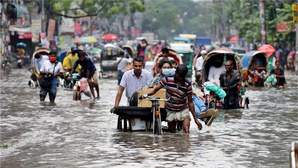New Delhi (IANS) India has witnessed an extreme weather disaster almost every day of the first nine months of this year — from heat and cold waves, cyclones and lightning to heavy rain, floods and landslides, the Centre for Science and Environment (CSE) said.
Between January 1 and September 30, such events hit the country with tenacious and frightening regularity and impact on 86 per cent of the days.
These disasters have claimed 2,923 human lives; impacted 1.84 million hectare (mha) of crop area; destroyed over 80,000 houses; and killed more than 92,000 livestock.
What’s more alarming is that in all probability, these calculations could be an underestimation — because data for each event is not collated nor are losses of public property or agriculture calculated.
These statistics are part of CSE’s and Down To Earth magazine’s new pre-COP28 assessment of extreme weather events in India in 2023, which was released here in an online media briefing on Tuesday.
“India 2023: An assessment of extreme weather events attempts to build an evidence base on the frequency and expanding geography of extreme weather events in the country. As this assessment clearly shows, what the country has witnessed so far in 2023 is the new ‘abnormal’ in a warming world,” said CSE director general Sunita Narain while releasing the assessment report.
What does the report say? India experienced extreme weather events on 235 of the 273 days — a little over 86 per cent of the days — from January 1 to September 30.
Madhya Pradesh was the state with the highest number of such events — 138. But the maximum number of people killed were in Bihar — 642 — followed by Himachal Pradesh and Uttar Pradesh: 365 and 341, respectively.
Punjab witnessed the maximum number of animal deaths, while Himachal Pradesh had the highest number of damaged houses.
In the southern region, Kerala recorded the maximum number of extreme weather days (67) and deaths (60). Telangana recorded the biggest affected crop area: over 62,000 hectare (ha); the state also had high animal deaths in this region (645). With over 11,000 houses destroyed, Karnataka suffered the most on this score.
In India’s northwest, Uttar Pradesh had the most extreme weather days at 113. Himachal Pradesh, Punjab, Haryana, Uttarakhand and Rajasthan all fared badly as well.
In the east and northeast, 102 events put Assam at the top of the table; the state also lost 159 livestock and over 48,000 ha of its crop area was devastated. In Nagaland, over 1,900 houses were destroyed.
While January remained slightly warmer than average, February exceeded all previous records to become the warmest in 122 years. India also experienced its sixth driest February and its driest August in 122 years.
Kiran Pandey, programme director, environmental resources unit, CSE, and one of the writers of this report says: “The report has a section on comparative analysis, which indicates that 2023 has seen more devastation compared to 2022. For instance, the impact of extreme weather events has been worse and been felt across the whole country in 2023 — all 36 states and Union territories have been affected this year, compared to 34 last year. The extent of cropped area that has suffered damages has widened — it was limited to 15 states last year; this year, 20 states are affected.”

